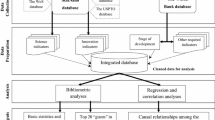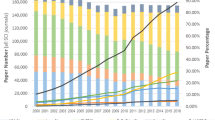Abstract
Nanotechnology is promising to be the ‘transformative’ technology of the 21st century with its boundless potential to revolutionize a wide range of industries. Stakes are high as projected estimate of market value and economic and social benefits are immense for countries that can attain competency in this technology. This has stimulated OECD countries as well as emerging economies to channel huge resources for developing core capabilities in this technology. Unlike, other key technologies, recent influential reports highlight China in particular and to some extent India, Brazil and other emerging economies competing with advanced OECD countries in ‘nanotechnology’. The present paper investigates through bibliometric and innovation indicators to what extent China and India have been able to assert their position in the global stage. The paper also underscores the importance of capturing indications from standards and products/processes along with publications and patents to capture more accurately the latent variable ‘performance’. Study shows that China’s progress is remarkable; it has already attained leading position in publications and standard development. India is making its presence more visible particularly in publications. China’s research is more sophisticated and addresses nano-materials and its applications whereas India’s research shows healthy trend towards addressing developmental problems.









Similar content being viewed by others
References
Altenburg, T., Schmitz, H., Stamm, A. (2008) Breakthrough? China’s and India’s Transition from Production to Innovation. World Development, 32(2), 325–344.
BCC (2011). 2010 Nanotechnology research review. BCC Research Market Forecasting Report Code: NAN047B.
Bhattacharya, S., Bhati, M. (2011). China’s emergence as a global nanotech player: Lessons for countries in transition. China Report, 47(4), 243–262.
Bhattacharya, S. & Lal, K. (2010). Innovation activity in the indian software industry. In A. Nadia et al. (Eds.) Liberalizing research in science and technology: Studies in science policy (pp 339-364). Saint-Petersburg: Politechnika.
Bhattacharya, S., Meyer, M., & Kretschmer, H. (2003). Characterizing intellectual spaces between science and technology. Scientometrics, 58(2), 369–390.
Brand, L. (2010). Report on statistical patent analysis; Observatory‐NANO, http://www.observatorynano.eu.
Chen, C. (2005). Citespace quick start guide, http://cluster.cis.drexel.edu/~cchen/citespace/.
Dang, Y., et al. (2009). Trends in worldwide nanotechnology patent applications: 1991–2008. Journal of Nanoparticle Research, 12(3), 687–706.
Glanzel, W. (2008). Seven myths in bibliometrics. About facts and fiction in quantitative science studies. In H. Kretschmer, & F. Havemann (Eds.), Proceedings of WIS 2008, Fourth International Conference on Webometrics, Informetrics and Scientometrics & Ninth COLLNET Meeting, Berlin: Humboldt University.
Hassan, M. H. A. (2005). Small things and big changes in the developing world. Science, 309, 65–66.
Hatto, P. (2009). Updates on standardization for nanotechnologies. London: DEFRA nanotechnology stakeholder forum.
Huang, C., Wu, Y. (2010). Sure bet or scientometric mirage? An assessment of Chinese progress in nanotechnology. United Nations University, Working Paper Series-2010-028.
Hullman, A. (2007). Measuring and assessing the development of nanotechnology. Scientometrics, 70(3), 739–758.
Kanama, D., & Kondo, A. (2007). Analysis of Japan’s nanotechnology competitiveness- concern for declining competitiveness and challenges for nanosystemization. Science and Technology Trends-Quarterly Review, 25, 36–49.
Kaplinsky, R., & Messner, D. (2007). Introduction: The impact of Asian drivers on the developing countries. World Development, 36(2), 197–207.
Kostoff, R. N. et al. (2007). DTIC Technical Report Number ADA 461930, Defense Technical Information Center, Fort Belvoir, VA, http://www.dtic.mil/.
Kostoff, R. N., et al. (2006). The structure and infrastructure of global nanotechnology literature. Journal of Nanoparticle Research, 8(34), 301–321.
Liu, L. (2009). Emerging nanotechnology power: Nanotechnology R&D and business trends in the Asia Pacific Rim. Singapore: World Scientific Publishing Co. Pvt. Ltd.
Lux Research. (2010). Ranking the nations on nanotech: Hidden havens and false threats.
Madhan, M., Chandrasekhar, G., & Arunachalam, S. (2010). Highly cited papers from India and China. Current Science, 99(6), 738–749.
Meyer, M. (2007). What do we know about innovation in nanotechnology? Some propositions about an emerging field between hype and path dependency. Scientometrics, 70(3), 779–810.
Miyazakia, K., & Islam, N. (2007). A nanotechnology system of innovation: An analysis of industry and academia research activities. Technovation, 27(11), 661–675.
NIC. (2004). Mapping the global future: Report of the national intelligence council’s 2020 Report, NIC (2004–2013).
NRM project report. (2006). FP6 program. European Commission, http://www.nanowerk.com/nanotechnology/reports/reportpdf/report74.pdf.
Porter, W. (2008). Nanotechnology law report, Washington, DC.
Porter, A., Cunningham, S. (1999). Whither nanotechnology? Foresight Update, Number 4, http://www.foresight.org/Updates/Update21/Update21.4.html.
Porter, A., & Youtie, J. (2008). How interdisciplinary is nanotechnology? Journal of Nanoparticle Research, 11(5), 1023–1041.
Preschitschek, N., & Bresser, D. (2010). Nanotechnology patenting in China and Germany: a comparison patent landscapes by bibliographic analyses. Journal of Business Chemistry, 7(1), 3–13.
Shapira, P., & Wang, J. (2009). From lab to market? Strategies and issues in the commercialization of nanotechnology in China. Asian Business and Management, 8(4), 461–489.
TERI. (2009). Nanotechnology developments in India: A status report. The Energy and Resources Institute, http://www.teriin.org/nano-uploads/D5_NT_Development_in_India_Apri_2010.pdf.
Tolles, W., & Roth, B. (2003). Nanotechnology, a stimulus for innovation. Current Science, 85(2), 1746–1759.
Vladimir, B. & Andrej, M. (2005). Program for analysis and visualization of large networks: Reference manual. Ljubljana: University of Ljubljana.
Wolfe, J. (2007). Nanotech gets big in China. Forbes/Wolfe Nanotech report.
Worldwatch Institute. (2006). State of the World.
Woodrow Wilson International Center for Scholars’ Project on Emerging Nanotechnologies database, www.nanotechproject.org.
Zhou, P., Leydesdorff, L. (2006). The emergence of China as a leading nation in science. Research Policy, 35(1), 83–104.
Acknowledgments
The authors thank the National Science and Technology Management Information System, Department of Science and Technology for supporting this study. We thank Ms Jayanthi A. Pushkaran for her helpful comments.
Author information
Authors and Affiliations
Corresponding author
Rights and permissions
About this article
Cite this article
Bhattacharya, S., Shilpa & Bhati, M. China and India: The two new players in the nanotechnology race. Scientometrics 93, 59–87 (2012). https://doi.org/10.1007/s11192-012-0651-7
Received:
Published:
Issue Date:
DOI: https://doi.org/10.1007/s11192-012-0651-7




